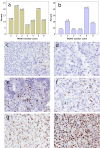High MCM3 expression is an independent biomarker of poor prognosis and correlates with reduced RBM3 expression in a prospective cohort of malignant melanoma
- PMID: 22805320
- PMCID: PMC3433373
- DOI: 10.1186/1746-1596-7-82
High MCM3 expression is an independent biomarker of poor prognosis and correlates with reduced RBM3 expression in a prospective cohort of malignant melanoma
Abstract
Background: Malignant melanoma is the most lethal form of skin cancer with a variable clinical course even in patients with thin melanomas and localized disease. Despite increasing insights into melanoma biology, no prognostic biomarkers have yet been incorporated into clinical protocols. Reduced expression of the RNA binding motif protein 3 (RBM3) has been shown to correlate with tumour progression and poor prognosis in melanoma and several other cancer forms. In ovarian cancer, an inverse association was found between expression of RBM3 and the minichromosome maintenance 3 (MCM3) gene and protein. In melanoma, gene expression analysis and immunohistochemical validation has uncovered MCM3 as a putative prognostic biomarker. The aim of the present study was to examine the associations of MCM3 expression with clinical outcome and RBM3 expression in a prospective, population-based cohort of melanoma.
Methods: Immunohistochemical MCM3 expression was examined in 224 incident cases of primary melanoma from the Malmö Diet and Cancer Study, previously analysed for RBM3 expression. Spearman's Rho and Chi-Square tests were used to explore correlations between MCM3 expression, clinicopathological factors, and expression of RBM3 and Ki67. Kaplan Meier analysis, the log rank test, and univariable and multivariable Cox proportional hazards modelling were used to assess the impact of MCM3 expression on disease-free survival (DFS) and melanoma-specific survival (MSS).
Results: High MCM3 expression was significantly associated with unfavourable clinicopathological features and high Ki67 expression. A significant inverse correlation was seen between expression of MCM3 and RBM3 (p = 0.025). High MCM3 expression was associated with a reduced DFS (HR = 5.62) and MSS (HR = 6.03), and these associations remained significant in multivariable analysis, adjusted for all other factors (HR = 5.01 for DFS and HR = 4.96 for MSS). RBM3 expression remained an independent prognostic factor for MSS but not DFS in the multivariable model.
Conclusions: These findings provide validation of the utility of MCM3 expression as an independent biomarker for prognostication of patients with primary melanoma. Moreover, the inverse association and prognostic impact of MCM3 and RBM3 expression indicate a possible interaction of these proteins in melanoma progression, the functional basis for which merits further study.
Virtual slides: The virtual slide(s) for this article can be found here: http://www.diagnosticpathology.diagnomx.eu/vs/1814908129755401.
Figures




Similar articles
-
Low RBM3 protein expression correlates with tumour progression and poor prognosis in malignant melanoma: an analysis of 215 cases from the Malmö Diet and Cancer Study.J Transl Med. 2011 Jul 21;9:114. doi: 10.1186/1479-5876-9-114. J Transl Med. 2011. PMID: 21777469 Free PMC article.
-
Decreased expression of RNA-binding motif protein 3 correlates with tumour progression and poor prognosis in urothelial bladder cancer.BMC Urol. 2013 Apr 8;13:17. doi: 10.1186/1471-2490-13-17. BMC Urol. 2013. PMID: 23565664 Free PMC article.
-
Gene expression profiling of primary cutaneous melanoma and clinical outcome.J Natl Cancer Inst. 2006 Apr 5;98(7):472-82. doi: 10.1093/jnci/djj103. J Natl Cancer Inst. 2006. PMID: 16595783
-
The Interplay between Tumour Microenvironment Components in Malignant Melanoma.Medicina (Kaunas). 2022 Mar 2;58(3):365. doi: 10.3390/medicina58030365. Medicina (Kaunas). 2022. PMID: 35334544 Free PMC article. Review.
-
Prognostic Biomarkers in Melanoma: Tailoring Treatments to the Patient.J Clin Aesthet Dermatol. 2021 Dec;14(12):44-48. J Clin Aesthet Dermatol. 2021. PMID: 35096254 Free PMC article. Review.
Cited by
-
Integrative Analysis of Minichromosome Maintenance Proteins and Their Prognostic Significance in Melanoma.Front Oncol. 2021 Aug 19;11:715173. doi: 10.3389/fonc.2021.715173. eCollection 2021. Front Oncol. 2021. PMID: 34490114 Free PMC article.
-
Elevated expression of minichromosome maintenance 3 indicates poor outcomes and promotes G1/S cell cycle progression, proliferation, migration and invasion in colorectal cancer.Biosci Rep. 2020 Jul 31;40(7):BSR20201503. doi: 10.1042/BSR20201503. Biosci Rep. 2020. PMID: 32597491 Free PMC article.
-
CDK1, CCNB1, CDC20, BUB1, MAD2L1, MCM3, BUB1B, MCM2, and RFC4 May Be Potential Therapeutic Targets for Hepatocellular Carcinoma Using Integrated Bioinformatic Analysis.Biomed Res Int. 2019 Oct 13;2019:1245072. doi: 10.1155/2019/1245072. eCollection 2019. Biomed Res Int. 2019. PMID: 31737652 Free PMC article.
-
The prognostic and clinicopathological significance of RBM3 in the survival of patients with tumor: A Prisma-compliant meta-analysis.Medicine (Baltimore). 2020 May;99(19):e20002. doi: 10.1097/MD.0000000000020002. Medicine (Baltimore). 2020. PMID: 32384455 Free PMC article.
-
Upregulation of minichromosome maintenance complex component 3 during epithelial-to-mesenchymal transition in human prostate cancer.Oncotarget. 2017 Jun 13;8(24):39209-39217. doi: 10.18632/oncotarget.16835. Oncotarget. 2017. PMID: 28424404 Free PMC article.
References
-
- Balch CM, Soong SJ, Gershenwald JE, Thompson JF, Reintgen DS, Cascinelli N, Urist M, McMasters KM, Ross MI, Kirkwood JM. et al.Prognostic factors analysis of 17,600 melanoma patients: validation of the American Joint Committee on Cancer melanoma staging system. J Clin Oncol. 2001;19(16):3622–3634. - PubMed
-
- Lee ML, Tomsu K, Von Eschen KB. Duration of survival for disseminated malignant melanoma: results of a meta-analysis. Melanoma Res. 2000;10(1):81–92. - PubMed
-
- Lindholm C, Andersson R, Dufmats M, Hansson J, Ingvar C, Moller T, Sjodin H, Stierner U, Wagenius G. Invasive cutaneous malignant melanoma in Sweden, 1990–1999. A prospective, population-based study of survival and prognostic factors. Cancer. 2004;101(9):2067–2078. doi: 10.1002/cncr.20602. - DOI - PubMed
Publication types
MeSH terms
Substances
LinkOut - more resources
Full Text Sources
Medical

